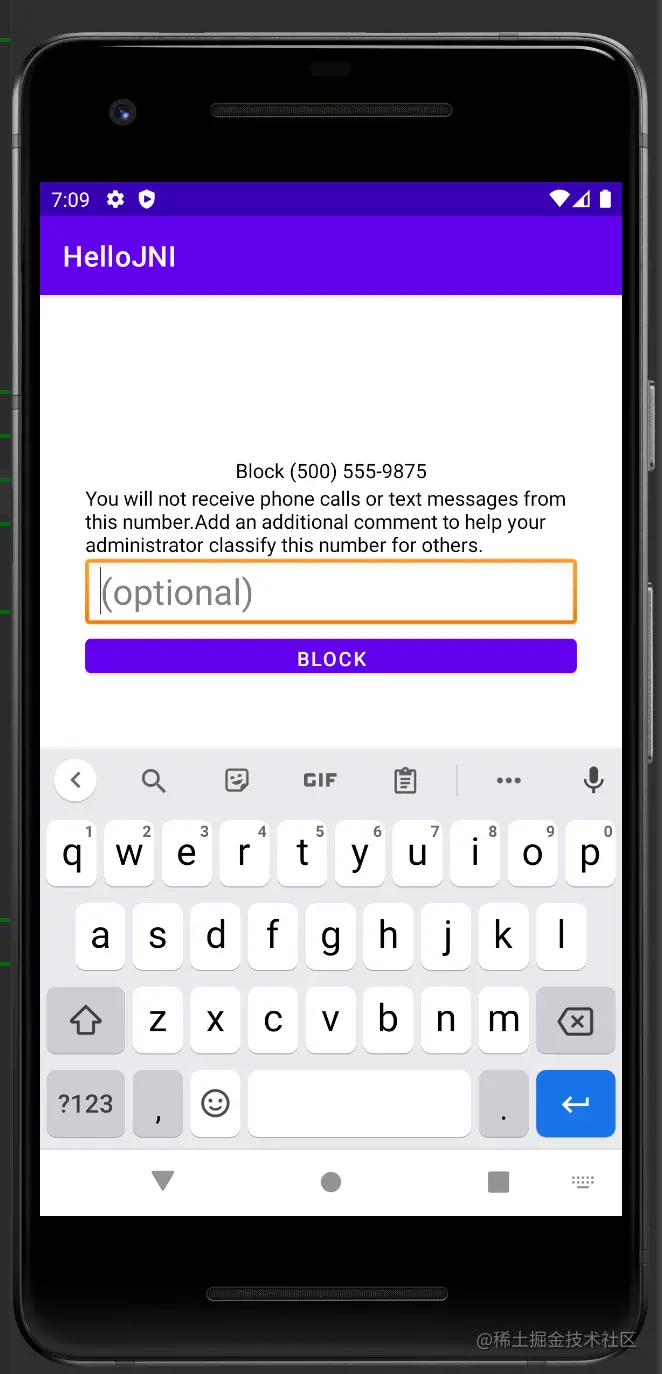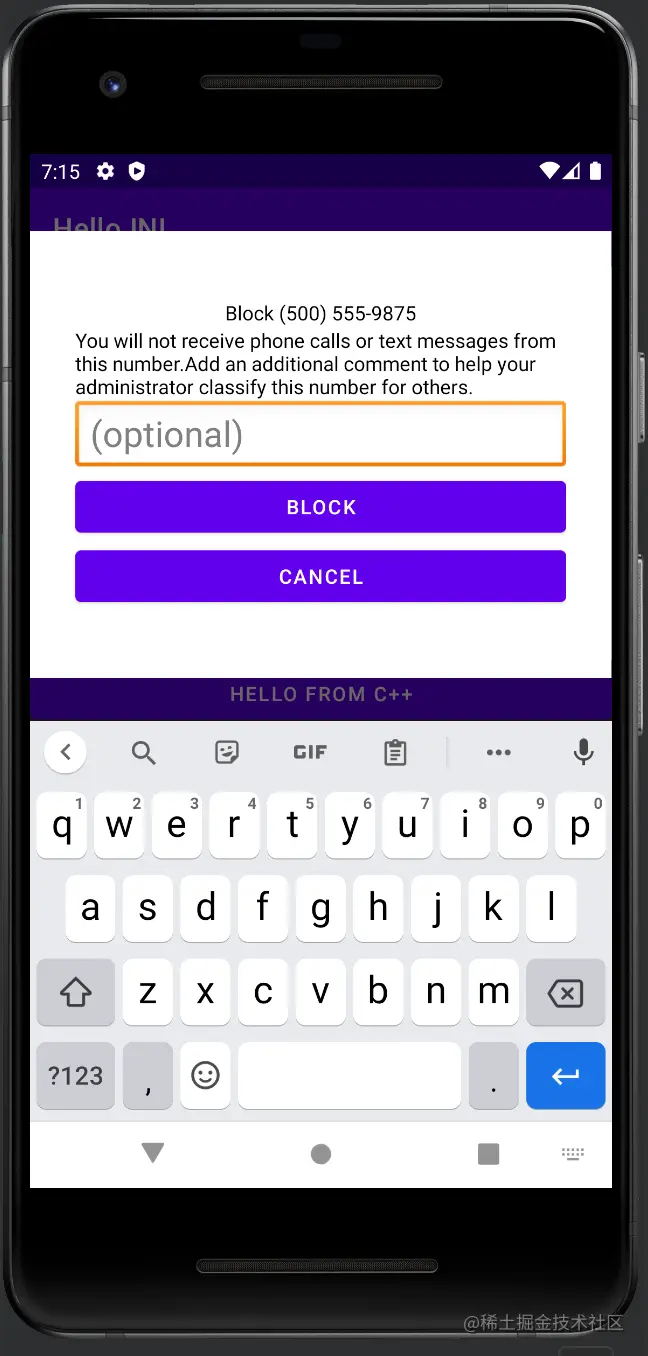目录
- 前言
- 方式一:继承DialogFragment,也是官方推荐的方式
- 事例
- 方式二:直接继承Dialog类或者AppCompatDialog类
- 更新
前言
大多数中,使用系统内置的dialog并不能满足UE的设计需要
方式一:继承DialogFragment,也是官方推荐的方式
通常我们只需要关注三个回调方法:
- onCreateDialog:创建一个dialog外壳
- onCreateView:给dialog外壳填充自己想要的样式布局
- onViewCreated:这里面给布局的view进行初始化操作,可以设置一些监听器等等
事例
自定义布局文件:随便写一个
<?xml version="1.0" encoding="utf-8"?>
<RelativeLayout xmlns:android="http://schemas.android.com/apk/res/android"
xmlns:app="http://schemas.android.com/apk/res-auto"
xmlns:tools="http://schemas.android.com/tools"
android:id="@+id/threat_call_rootView"
android:layout_width="match_parent"
android:layout_height="wrap_content"
android:background="@drawable/dialog_white_big_corner_roundrect_bg">
<LinearLayout
android:id="@+id/threat_call_container"
android:layout_width="match_parent"
android:layout_height="wrap_content"
android:background="@drawable/dialog_white_big_corner_roundrect_bg"
android:orientation="vertical"
android:paddingLeft="32dp"
android:paddingTop="48dp"
android:paddingRight="32dp"
android:paddingBottom="48dp">
<TextView
android:id="@+id/threat_call_number"
android:layout_width="match_parent"
android:layout_height="wrap_content"
android:gravity="center"
android:text="标题"
android:textColor="@color/black"
android:textSize="20sp"
android:textStyle="bold" />
<TextView
android:id="@+id/threat_call_desc"
android:layout_width="match_parent"
android:layout_height="wrap_content"
android:layout_marginTop="4dp"
android:lineSpacingExtra="3sp"
android:text="正文"
android:textColor="@color/black"
android:textSize="14sp" />
<EditText
android:id="@+id/threat_call_edittext"
android:layout_width="match_parent"
android:layout_height="48dp"
android:layout_marginTop="16dp"
android:width="100dp"
android:background="@drawable/sip_threat_call_dialog_edittext_stroke"//给editText加个外边框
android:hint=" (optional)"
android:lineSpacingExtra="3sp"
android:maxLength="255"
android:minLines="1"
android:paddingLeft="5dp"//这个属性的一个妙用可以改变光标的起始位置,不然光标有可能看不到
android:text=""
android:textCursorDrawable="@null"
android:textSize="14sp"
app:layout_constraintBottom_toBottomOf="parent"
app:layout_constraintEnd_toEndOf="parent"
app:layout_constraintStart_toStartOf="parent"
app:layout_constraintTop_toTopOf="parent" />
<Button
android:id="@+id/threat_call_block_btn"
android:layout_width="match_parent"
android:layout_height="48dp"
android:layout_marginTop="16dp"
android:background="@drawable/sip_threat_call_dialog_btn_bg"
android:gravity="center"
android:text="BLOCK"
android:textStyle="bold" />
<Button
android:id="@+id/threat_call_cancel_btn"
android:layout_width="match_parent"
android:layout_height="48dp"
android:layout_marginTop="1dp"
android:background="@drawable/sip_threat_call_dialog_btn_bg"
android:gravity="center"
android:text="CANCEL"
android:textStyle="bold" />
</LinearLayout>
</RelativeLayout>
selfFragment类:
package com.example.hellojni;
import android.animation.ObjectAnimator;
import android.annotation.SuppressLint;
import android.app.Dialog;
import android.content.Context;
import android.content.DialogInterface;
import android.graphics.Color;
import android.graphics.drawable.ColorDrawable;
import android.os.Bundle;
import android.view.Gravity;
import android.view.LayoutInflater;
import android.view.MotionEvent;
import android.view.View;
import android.view.ViewGroup;
import android.view.Window;
import android.view.WindowManager;
import android.view.inputmethod.InputMethodManager;
import android.widget.EditText;
import androidx.annotation.NonNull;
import androidx.annotation.Nullable;
import androidx.fragment.app.DialogFragment;
public class selfDialogFragment extends DialogFragment {
View container;
@NonNull
@Override
public Dialog onCreateDialog(@Nullable Bundle savedInstanceState) {
return new Dialog(getContext(),R.style.bottom_dialog);
// return super.onCreateDialog(savedInstanceState);//不采用系统默认的dialog样式,自定义dialog主题
}
@Nullable
@Override
public View onCreateView(@NonNull LayoutInflater inflater, @Nullable ViewGroup container, @Nullable Bundle savedInstanceState) {
Window window = getDialog().getWindow();
window.setLayout(WindowManager.LayoutParams.MATCH_PARENT,WindowManager.LayoutParams.WRAP_CONTENT);
window.setGravity(Gravity.CENTER);//设置dialog位置处于中央
if(!iPaid(getContext())){
window.getDecorView().setMinimumWidth(getResources().getDisplayMetrics().widthPixels);//这个设置的目的是为了让dialog横向宽度是充满屏幕的
}
// window.setSoftInputMode(WindowManager.LayoutParams.SOFT_INPUT_ADJUST_RESIZE);//本来想解决dialog打开软键盘后,弹窗跟着往上走的效果,效果确实有,不过依然没有解决我的问题,下面会详解。
return inflater.inflate(R.layout.dialog_block_reason,container,false);
}
@Override
public void onViewCreated(@NonNull View view, @Nullable Bundle savedInstanceState) {
super.onViewCreated(view, savedInstanceState);
View dialogViewContent = view.findViewById(R.id.block_number_container);
EditText editText = view.findViewById(R.id.optional_block_number);
container = view.findViewById(R.id.block_number_container);
editText.requestFocus();
InputMethodManager imm = (InputMethodManager) getActivity().getSystemService(Context.INPUT_METHOD_SERVICE);
dialogViewContent.setOnTouchListener(new View.OnTouchListener() {
@SuppressLint("ClickableViewAccessibility")
@Override
public boolean onTouch(View v, MotionEvent event) {
//强制收起软件盘的方式:
InputMethodManager imm = (InputMethodManager) getActivity().getSystemService(Context.INPUT_METHOD_SERVICE);
imm.hideSoftInputFromWindow(editText.getWindowToken(),0);
return false;
}
});
view.findViewById(R.id.cancel_btn).setOnClickListener(new View.OnClickListener() {
@Override
public void onClick(View view) {
dismissAllowingStateLoss();
hideSoftInputAndDissmissDialog();
}
});
private void hideSoftInputAndDissmissDialog() {
dismissAllowingStateLoss();
if (getActivity() != null) {//为了解决dialog弹出软键盘退出界面后软键盘依然存在的问题
getActivity().getWindow().setSoftInputMode(WindowManager.LayoutParams.SOFT_INPUT_STATE_ALWAYS_HIDDEN);
}
}
@Override
public void onStart() {
super.onStart();
}
//判断是否为Pad的方法,通过计算屏幕对角线长度
private boolean isPad(Context context) {
WindowManager wm = (WindowManager) context.getSystemService(Context.WINDOW_SERVICE);
Display display = wm.getDefaultDisplay();
DisplayMetrics dm = new DisplayMetrics();
display.getMetrics(dm);
double x = Math.pow(dm.widthPixels / dm.xdpi, 2);
double y = Math.pow(dm.heightPixels / dm.ydpi, 2);
double screenInches = Math.sqrt(x + y); // 屏幕尺寸
return screenInches >= 7.0;
}
}
- 坑点讲解
- 当dialog有editText的时候,如果你的dialog主题中的
<item name="android:windowIsFloating">false</item> 指定为false的话,即便加上了 window.setSoftInputMode(WindowManager.LayoutParams.SOFT_INPUT_ADJUST_RESIZE);也不行 效果如下:可以清楚的看到,软键盘还是挡住了两个按钮

android:windowIsFloating设为true时,效果如下:

不过中间多出来的那块我也不知道受什么因素影响的,目前这个样式还能凑活用吧
- 默认的dialog并非是横向充满屏幕的
我这边用了使用了window.getDecorView().setMinimumWidth(getResources().getDisplayMetrics().widthPixels); 生效了,有的博客说是使用 window.getDecorView().setPadding(0,0,0,0)或者主题中有个属性android:windowFullscree,不过这两个我试过都貌似都没有什么效果
- 当打开软键盘,然后点击空白处的时候,dialog消失,但是软键盘却还是打开着。
这个点我使用了getActivity().getWindow().setSoftInputMode(WindowManager.LayoutParams.SOFT_INPUT_STATE_ALWAYS_HIDDEN);解决了,这句话等同于在展示dialog的activity中androidMenifests文件中设置 andorid:windowSoftInputMode = stateAlwaysHidden,而仅仅设置成stateHidden是不够的,具体这两个参数的详细区别,官方文档说的也很含糊,反正我没读懂。
我比较认同这篇文章的看法: Android 进入Activity时如何禁止弹出软键盘输入法
- 默认的dialog出场以及退场动画是采用了缩放以及透明度,可以在主题中自定义出场动画
enter动画:
<?xml version="1.0" encoding="utf-8"?> <translate xmlns:android="http://schemas.android.com/apk/res/android" android:fromYDelta="100%p" android:interpolator="@android:anim/accelerate_decelerate_interpolator" android:toYDelta="50%p" android:duration="200"> </translate>
exit动画:
<?xml version="1.0" encoding="utf-8"?>
<set xmlns:android="http://schemas.android.com/apk/res/android"
android:shareInterpolator="false" >
<scale android:fromXScale="1.0" android:toXScale="0.9"
android:fromYScale="1.0" android:toYScale="0.9"
android:pivotX="50%" android:pivotY="50%"
android:interpolator="@android:anim/decelerate_interpolator"
android:duration="150" />
<alpha android:fromAlpha="1.0" android:toAlpha="0.0"
android:interpolator="@android:anim/decelerate_interpolator"
android:duration="150"/>
</set>
方式二:直接继承Dialog类或者AppCompatDialog类
通常只需要关注onCreate方法,在该方法中,一般需要做如下几个事情:
- 通过
setContentView将自定义的布局填充到dialog中去 - 初始化布局中的子view,并设置监听器,事件响应等
- 初始化window相关的属性,比如设置window的宽度和高度,以及window所显示的位置等等
在构造函数中设置想要的主题:这里提供两种比较常用的主题
<!--对话框会在屏幕中间显示-->
<style name="dialog_theme_center_dispay" parent="@android:style/Theme.Dialog">
<item name="android:windowFrame">@null</item><!-- 设置dialog空白背景-->
<item name="android:windowIsFloating">true</item> <!-- dialog是否悬浮,当有软键盘的时候会被顶上去-->
<item name="android:windowIsTranslucent">false</item> <!-- dialog是否半透明 -->
<item name="android:windowMinWidthMinor">100%</item> <!-- dialog横向宽度充满整个屏幕 -->
<item name="android:windowNoTitle">true</item><!-- dialog是否有标题 -->
<item name="android:windowBackground">@color/transparent</item><!-- dialog背景是透明的 -->
<item name="android:background">@color/transparent</item>
<item name="android:backgroundDimEnabled">true</item>
<item name="android:windowSoftInputMode">stateHidden|adjustResize</item>
</style>
<!--对话框会从底部弹出-->
<style name="dialog_theme_bottom2top">
<item name="android:windowFrame">@null</item>
<item name="android:windowIsFloating">true</item>
<item name="android:windowIsTranslucent">false</item>
<item name="android:windowNoTitle">true</item>
<item name="android:windowBackground">@color/transparent</item>
<item name="android:backgroundDimEnabled">true</item> <!--是否允许对话框的背景变暗:如果允许背景就变暗了。-->
<item name="android:windowMinWidthMinor">100%</item><!--宽度铺满全屏-->
<item name="android:windowCloseOnTouchOutside">true</item><!--点击阴影的地方是否可以关闭对话框-->
<item name="android:windowAnimationStyle">@style/dialog_anim_bottom2top</item><!--对话框动画-->
<item name="android:windowSoftInputMode">stateHidden|adjustResize</item>
</style>
<!--[对话框动画]对话框会从底部弹出-->
<style name="dialog_anim_bottom2top" parent="@android:style/Animation">
<item name="android:windowEnterAnimation">@anim/bottom_in</item>
<item name="android:windowExitAnimation">@anim/bottom_out</item>
</style>
bottom_in:
<?xml version="1.0" encoding="utf-8"?>
<set xmlns:android="http://schemas.android.com/apk/res/android">
<translate
android:duration="300"
android:fromYDelta="100%p"
android:toYDelta="0" />
</set>
bottom_out:
<?xml version="1.0" encoding="utf-8"?>
<set xmlns:android="http://schemas.android.com/apk/res/android">
<translate
android:duration="200"
android:fromYDelta="0"
android:toYDelta="50%p" />
<alpha
android:duration="200"
android:fromAlpha="1.0"
android:toAlpha="0.0" />
</set>
更新
辨别当前设备是否是平板的方法通常有两种:
public static boolean isLargeScreen(Context context) {
Configuration config = context.getResources().getConfiguration();
int size = config.screenLayout & Configuration.SCREENLAYOUT_SIZE_MASK;
return (size >= Configuration.SCREENLAYOUT_SIZE_LARGE);
}
public static boolean isPad(Context context) {
WindowManager wm = (WindowManager) context.getSystemService(Context.WINDOW_SERVICE);
Display display = wm.getDefaultDisplay();
DisplayMetrics dm = new DisplayMetrics();
display.getMetrics(dm);
double x = Math.pow(dm.widthPixels / dm.xdpi, 2);
double y = Math.pow(dm.heightPixels / dm.ydpi, 2);
double screenInches = Math.sqrt(x + y); // 屏幕尺寸
return screenInches >= 7.0;
}
到此这篇关于Android自定义Dialog的2种常见方法的文章就介绍到这了,更多相关Android自定义Dialog内容请搜索自由互联以前的文章或继续浏览下面的相关文章希望大家以后多多支持自由互联!
